Knee Osteoarthritis Relief Program
Osteoarthritis of the Knee

Osteoarthritis of the knee is a condition where the cartilage, which acts as a cushion in the joint, wears down due to aging, muscle loss, and other factors, causing pain. As the cartilage wears away, the space between the bones in the knee joint becomes narrower, exposing the inner bone, which can lead to spiky growths on the bone edges or bone deformities.
The knee is said to bear 2.3 times the weight of the body, making it particularly vulnerable to stress and damage. Moreover, the knee has the most complex and unstable structure in the human body, functioning as the pivotal point for movement.
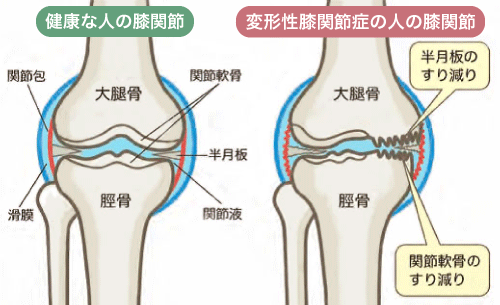
With the aging population, degenerative diseases based on aging changes are steadily increasing. In orthopedic disorders, osteoarthritis (OA) is one of the most common conditions seen in outpatient care.
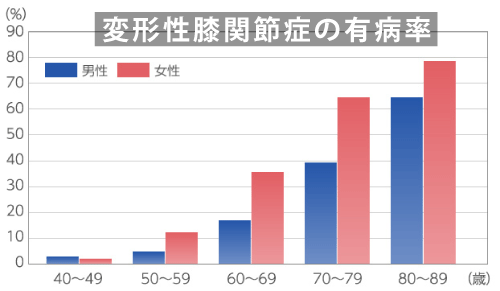
The male-to-female ratio is 1:4, with women being overwhelmingly more likely to develop it, especially obese women over the age of 40, who are more prone to its onset.
The frequency of this condition has been steadily increasing, and it is said that about 80% of people over the age of 60 have some form of osteoarthritis (OA) visible on X-rays. Osteoarthritis of the knee joint is the most common type of OA, and if it progresses, it can significantly impair daily activities due to pain while walking.
Causes and Classification
Osteoarthritis of the knee can be divided into “primary,” where there is no obvious cause, and “secondary,” where the cause is known, such as from illness or injury. The majority of cases are “primary.” Osteoarthritis of the knee is a disease that results from a combination of many factors, and various risk factors are involved in its onset and progression.
“Primary” osteoarthritis of the knee occurs as the articular cartilage of the knee wears down with age, and factors such as obesity are considered to be involved. “Secondary” osteoarthritis of the knee has various causes, with trauma being the most common.
It is difficult to clearly separate these factors, as they influence each other closely and contribute to the formation of the pathology.
Degenerative changes in articular cartilage (deformation due to aging or senescence), along with mechanical stimuli from load and joint movement, cause deformation of the joint through friction and lead to proliferative changes. However, it can also occur due to obesity, arteriosclerosis, activation of joint cartilage degrading enzymes, and the influence of sex hormones.
Main Symptoms
The main symptoms of osteoarthritis of the knee are pain and swelling. Fluid (synovial fluid) may also accumulate in the joint.
Osteoarthritis of the knee progresses over time, with symptoms gradually worsening. Let’s break down the progression of osteoarthritis of the knee into three stages.

In the early stage, there is pain (pain during movement) when standing up or starting to walk, but the pain usually goes away after resting.
In the middle stage, the frequency of pain during movement increases, and actions like sitting cross-legged, squatting, or going up and down stairs become difficult. The bending and straightening of the knee also become painful, and the range of motion in the knee joint is restricted (range of motion limitation).
In the late stage, the knee does not fully bend or straighten, and walking becomes difficult. This leads to difficulty performing daily activities. Additionally, the deformation of the knee joint becomes more noticeable, and knock-knees may develop.
As you can see, knee pain worsens in stages. Stiffness, discomfort, and pain in the knee may be early symptoms of osteoarthritis of the knee.
Diagnosis
The diagnosis is made through interviews, physical examination, and sometimes palpation to check for tenderness on the inner side of the knee, range of motion, swelling, and O-leg deformity. X-ray (radiography) is used for diagnosis, and MRI may also be performed if necessary.

X-ray of Osteoarthritis of the Knee
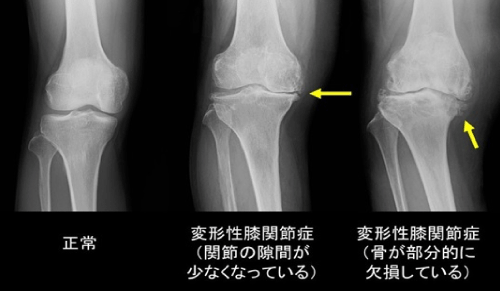
In an X-ray examination, the condition of the knee joint is observed. X-ray is performed while standing. In osteoarthritis of the knee, X-rays may show subchondral bone sclerosis (hardening of the bone under the cartilage), narrowing of the joint space, and osteophytes (bone spurs).
General Treatment Methods
The treatment goal for osteoarthritis of the knee is to relieve pain, improve knee joint function, and prevent deterioration in daily activities. Treatment is generally divided into “conservative therapy” and “surgical therapy.” Regardless of the progression stage, conservative therapy is initially performed, but if pain persists and daily life is affected despite conservative therapy, surgical therapy may be considered.
Conservative Therapy
Conservative therapy is based on “lifestyle guidance,” combined with “exercise therapy,” “pharmacological therapy,” and “orthotic therapy.”
If a person avoids movement due to knee pain and becomes sedentary, the muscle strength supporting the knee decreases, leading to weight gain. As a result, the burden on the knee increases, and the pain worsens, creating a vicious cycle. As part of conservative therapy, lifestyle guidance primarily focuses on exercise, weight reduction, and diet.
Exercise therapy is conducted to strengthen the muscles around the knee joint and reduce the load on the knee joint. Exercises like SLR (Straight Leg Raise) are centered on training the muscles on the front of the thigh (quadriceps).
Pharmacological therapy for osteoarthritis of the knee includes “oral medication,” “topical medication,” and “intra-articular injections.”
Orthotic devices that reduce the burden on the knee and stabilize the joint include insoles, functional knee braces, supports, and canes.
Surgical Therapy
If conservative therapy does not provide sufficient results and daily life is affected, surgical therapy may be performed. Major surgeries for osteoarthritis of the knee include “arthroscopic surgery (arthroscopic debridement),” “high tibial osteotomy,” and “total knee arthroplasty.”
Medical Japan’s Oriental Medicine Approach
Anti-inflammation, pain relief, and promotion of blood circulation around the knee joint
If there are tender points or joint edema around the knee joint, treatment is performed to promote water metabolism.
[Prescription example]Liangqiu, Xuehai, Weichong, Heding, Gaigeki, Naigeki
For joint edema: Moxibustion on Liangqiu, Xuehai, Naigeyan, and Naigeyan
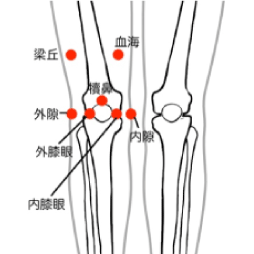
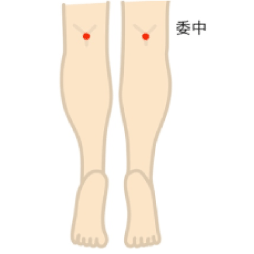
Medical Japan Intervention Examples
Astron
Symptoms
Common in middle-aged and elderly individuals, particularly those who are overweight and women
Causes include cartilage degeneration due to aging, obesity, and overloading of the meniscus due to muscle weakness
Symptoms include pain, range of motion restrictions, lateral instability, swelling, warmth, and crepitus
| Ultrasound | |||
|---|---|---|---|
| Time | Frequency | Output Intensity | Duty |
| 5-10 minutes | 1&3MHz | 1.0~1.5W/cm2 | 100% |
| Tectron | ||||
|---|---|---|---|---|
| Mode | Output Level | Hammer | Interval | Polarity Switch |
| A | Exercise threshold level | OFF | OFF | 1 minute |
Points
Position: Seated with the knee slightly bent
Notes: Direct the ultrasound towards the knee joint
Electrode position: Lateral vastus (when there is pain on the inside)
Electrode position: When there is pain on the inner side, fix the electrode to the inner side of the knee joint with multiple attachments. If there is no change in pain, place the electrode at the popliteal fossa
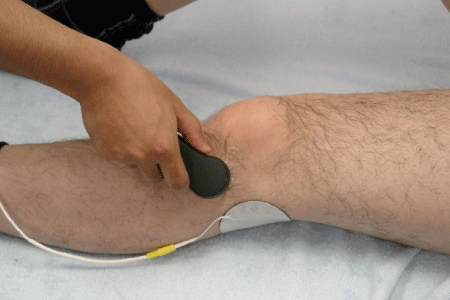
Balance Correction Exercise
The cortical motor area is involved in actions such as standing, walking, and running, and is responsible for controlling muscles and joints. By retraining this motor area, one can learn which muscles to use at the correct timing, allowing the body to function smoothly without performing incorrect movements. This helps prevent recurrence.
As a result, pain is reduced, and normal daily activities can be resumed, which is considered “true treatment.” Medical Japan utilizes rehabilitation knowledge to support improvement of the root cause.
Approach to the Popliteus and Semimembranosus Muscles for Knee Joint Pain
We introduce safe and effective treatments for knee pain and deformities, focusing on the hamstring and semimembranosus muscles. Methods to improve the flexibility and elasticity of these muscles are explained.
Medical Fitness for Osteoarthritis of the Knee
Approach to the Popliteus Muscle for Osteoarthritis of the Knee with M-Cube Wave
Avoid a lifestyle involving kneeling. Strengthening the quadriceps (front thigh muscles) is also effective.
Exposure to air conditioning that cools the knee and impairs blood circulation can worsen symptoms, so it is important to warm up and promote blood circulation. For individuals who are overweight, weight loss is also considered a part of rehabilitation.
We don’t just give massages.
We look for the root cause of why the pain is occurring, analyze the lack of muscle strength and center of gravity movement from the walking motion, and provide treatment that is appropriate for the patient.
We also incorporate posture guidance and compression training to prevent recurrence.
We always teach simple exercises that can be done at home and the correct way to sit, stand, and walk that are appropriate for each patient. By consciously working on what we teach every day, we can make the wishes of our patients come true. Come and work with us to make your body right!
Intervention examples that only Medical Japan can provide
There are surgical treatments (removing pain through surgery) and conservative treatments (recovery without surgery), but here we will talk about the conservative treatments (recovery without surgery) that we provide.
AI posture analysis system

From the current posture, it is possible to estimate areas where muscles are stiff, areas that cause pain, future posture, etc., and to explain the treatment policy and effects more clearly. It has become easier for patients to understand their own physical condition.

This will help you know which muscles to relax and which muscles to train. By recognizing your own body, you will know what needs to be improved. Of course, more precise treatment will be possible. Based on this analysis, we can then recommend the best training and stretching methods for you.
Foot care




German-style foot care
We use special equipment from Germany to treat corns and calluses, so we can remove the core without hurting the skin and without pain. Of course, you can walk home immediately after treatment.
We use special equipment to neatly trim thick and rough nails, leaving them smooth and shiny.

Myopressure (Gait diagnosis machine)


When you walk on a treadmill with about 20,000 moving sensors, you can see your foot pressure, center of gravity movement, and left and right load values. In addition, by using two cameras, you can visually check your walking posture.
After a year and a half of rehabilitation, there has been such a change!!
Insoles and shoe prescriptions


By inserting an insole that fits your body, you can bring out the natural function of your foot, firmly support the arch of your foot, and make it easier to put the correct center of gravity on it. It also improves performance, improves endurance, reduces fatigue, and reduces stress on muscles and the human body, making everyday walking easier.
【Realign Core】【Realign Balance Shoes】

Realign Core is an exercise aid for correcting distortions of the pelvis and rib cage, which form the center (core) of the body. If there is a “distortion (asymmetry)” in the pelvis or thorax, it can have a negative effect not only on the entire spine, but also on the motor function of the shoulders, neck, and hip joints.
Thomson Bed


This is a special bed used by American chiropractors to correct the pelvis and skeleton, applying chiropractic techniques. The head, chest, lumbar, and pelvic parts of the bed move up and down independently, allowing you to use your own body weight and gravity to return the distortion to the correct position with minimal effort in the targeted area.
Recommendation from a Doctor
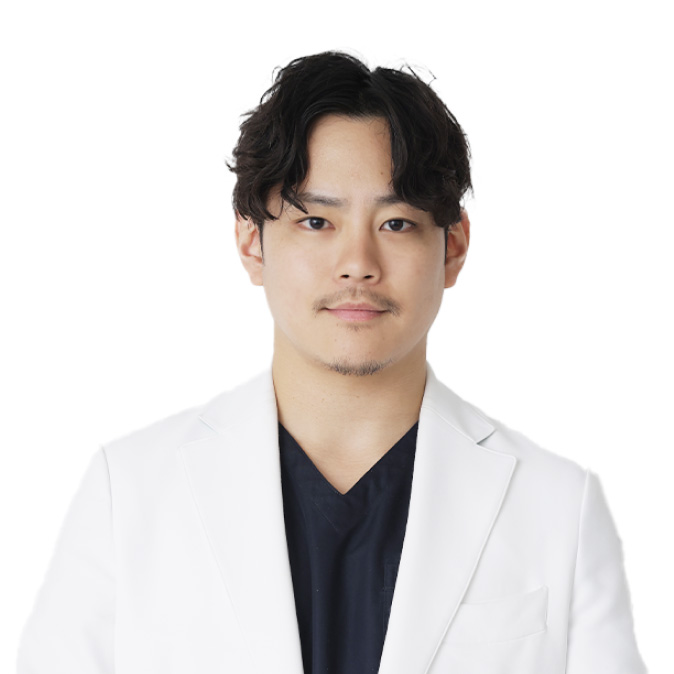

Career and Achievements
・Graduated from Kyoto University Faculty of Engineering, Department of Physics Engineering
・Completed special training at Harvard Medical School
・Graduated from Nara Medical University
・Cosmetic surgeon, cosmetic dermatologist, orthopedic surgeon
I am Dr. Ryohei Tsuchida, the director of Tokyo Bisen Clinic Shibuya. At our clinic, we use our expertise in orthopedics to treat a variety of musculoskeletal symptoms. We also have an X-ray room and provide highly accurate diagnoses.
We treat a wide range of musculoskeletal symptoms, but we highly recommend the treatments offered by Medical Japan as a reliable form of treatment.
For example:
Acupuncture and osteopathy to improve pain and numbness from the root
We aim to improve the root causes of pain and numbness, such as stiff shoulders, lower back pain, arthritis, fasciosis, and neuralgia, and achieve sustainable recovery.
Rehabilitation and evaluation analysis to prevent recurrence
We create individual rehabilitation plans based on detailed evaluations to prevent recurrence of knee and shoulder joint diseases, recurring lower back pain, and other conditions.
Training to strengthen the body
We strengthen the body after recovery to prevent recurrence, sports injuries, and muscle weakness.
Medical Japan provides evidence-based comprehensive health support, and is especially recommended for those suffering from musculoskeletal problems such as stiff shoulders, back pain, arthritis, fasciosis, and sports injuries.
Voices of joy from patients
